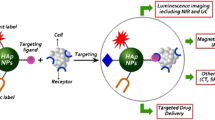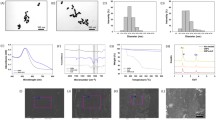Abstract
Functionalized Au NPs have received considerable recent interest for targeting and labeling cells and tissues. Damaged bone tissue can be targeted by functionalizing Au NPs with molecules exhibiting affinity for calcium. Therefore, the relative binding affinity of Au NPs surface functionalized with either carboxylate (l-glutamic acid), phosphonate (2-aminoethylphosphonic acid), or bisphosphonate (alendronate) was investigated for targeted labeling of damaged bone tissue in vitro. Targeted labeling of damaged bone tissue was qualitatively verified by visual observation and backscattered electron microscopy, and quantitatively measured by the surface density of Au NPs using field-emission scanning electron microscopy. The surface density of functionalized Au NPs was significantly greater within damaged tissue compared to undamaged tissue for each functional group. Bisphosphonate-functionalized Au NPs exhibited a greater surface density labeling damaged tissue compared to glutamic acid- and phosphonic acid-functionalized Au NPs, which was consistent with the results of previous work comparing the binding affinity of the same functionalized Au NPs to synthetic hydroxyapatite crystals. Targeted labeling was enabled not only by the functional groups but also by the colloidal stability in solution. Functionalized Au NPs were stabilized by the presence of the functional groups, and were shown to remain well dispersed in ionic (phosphate buffered saline) and serum (fetal bovine serum) solutions for up to 1 week. Therefore, the results of this study suggest that bisphosphonate-functionalized Au NPs have potential for targeted delivery to damaged bone tissue in vitro and provide motivation for in vivo investigation.






Similar content being viewed by others
References
Alkilany AM, Nagaria PK, Hexel CR, Shaw TJ, Murphy CJ, Wyatt MD (2009) Cellular uptake and cytotoxicity of gold nanorods: molecular origin of cytotoxicity and surface effects. Small 5(6):701–708
Aslam M, Fu L, Su M, Vijayamohanan K, Dravid VP (2004) Novel one-step synthesis of amine-stabilized aqueous colloidal gold nanoparticles. J Mater Chem 14:1795–1797
Burr DB, Forwood MR, Fyhrie DP, Martin RB, Schaffler MB, Turner CH (1997) Bone microdamage and skeletal fragility in osteoporotic and stress fractures. J Bone Miner Res 12(1):6–15
Cai QY, Kim SH, Choi KS, Kim SY, Byun SJ, Kim KW, Park SH, Juhng SK, Yoon K-H (2007) Colloidal gold nanoparticles as a blood-pool contrast agent for X-ray computed tomography in mice. Invest Radiol 42(12):797–806
Chapurlat BD, Delmas PD (2009) Bone microdamage: a clinical perspective. Osteoporos Int 20:1299–1308
Eck W, Nicholson AI, Zentgraf H, Semmler W, Bartling S (2010) Anti-CD4-targeted gold nanoparticles induce specific contrast enhancement of peripheral lymph nodes in X-ray computed tomography of lice mice. Nano Lett 10(7):2318–2322
Hainfeld JF, Slatkin DN, Focella TM, Smilowitz HM (2006) Gold nanoparticles: a new X-ray contrast agent. Br J Radiol 79(939):248–253
Hainfeld JF, O’Connor MJ, Bilmanian FA, Slatkin DN, Adams DJ, Smilowitz HM (2010) Micro-CT enables microlocalisation and quantification of Her2-targeted gold nanoparticles within tumour regions. Br J Radiol 84(1002):526–533
Hermann R, Walther P, Muller M (1996) Immunogold labeling in scanning electron microscopy. Histochem Cell Biol 106:31–39
Jackson PA, Rahman WNWA, Wong CJ, Ackerly T, Geso M (2010) Potential dependent superiority of gold nanoparticles in comparison to iodinated contrast agents. Eur J Radiol 75(1):104–109
Kim D, Park S, Lee JH, Jeong YY, Jon S (2007) Antibiofouling polymer-coated gold nanoparticles as a contrast agent for in vivo X-ray computed tomography imaging. J Am Chem Soc 129(24):7661–7665
Knothe-Tate ML, Steck R, Forwood MR, Niederer P (2000) In vivo demonstration of load-induced fluid flow in the rat tibia and its potential implications for processes associated with functional adaptation. J Exp Biol 203:2737–2745
Kumar A, Mandal S, Selvakannan PR, Pasricha R, Mandale AB, Sastry M (2003) Investigation into the interaction between surface-bound alkylamines and gold nanoparticles. Langmuir 19:6277–6282
Landrigan MD, Li J, Turnbull TL, Burr DB, Niebur GL, Roeder RK (2011) Contrast-enhanced micro-computed tomography of fatigue microdamage accumulation in human cortical bone. Bone 48(3):443–450
Lee TC, Mohsin S, Taylor D, Parkesh R, Gunnlaugsson T, O’Brien FJ, Giehl M, Gowin W (2003) Detecting microdamage in bone. J Anat 203:161–172
Leff DV, Brandt L, Heath JR (1996) Synthesis and characterization of hydrophobic, organically-soluble gold nanocrystals functionalized with primary amines. Langmuir 12:4723–4730
Leng H, Wang X, Ross RD, Niebur GL, Roeder RK (2008) Micro-computed tomography of fatigue microdamage in cortical bone using a barium sulfate contrast agent. J Mech Behav Biomed Mater 1(1):68–75
Nancollas GH, Tang R, Phipps RJ, Henneman Z, Gulde S, Wu W, Mangood A, Russell RGG, Ebetino FH (2006) Novel insights into actions of bisphosphonates on bone: differences in interactions with hydroxyapatite. Bone 38:617–627
O’Brien FJ, Taylor D, Lee TC (2002) An improved labelling technique for monitoring microcrack growth in compact bone. J Biomech 35:523–526
Parkesh R, Mohsin S, Lee TC, Gunnlaugsson T (2007) Histological, spectroscopic, and surface analysis of microdamage in bone: toward real-time analysis fluorescent sensors. Chem Mater 19:1656–1663
Podzimek S (2011) Light scattering, size exclusion chromatograph and asymmetric field flow fractionation. Wiley, Hoboken
Popovtzer R, Agrawal A, Kotov NA, Popovtzer A, Balter J, Carey TE, Kopelman R (2008) Targeted gold nanoparticle enable molecular CT imaging of cancer. Nano Lett 8(12):4593–4596
Ross RD, Roeder RK (2011) Binding affinity of surface functionalized gold nanoparticles for hydroxyapatite. J Biomed Mater Res 99A:58–66
Selvakannan PR, Mandal S, Phadtare S, Pasricha R, Sastry M (2003) Capping of gold nanoparticles by the amino acid lysine renders them water-dispersible. Langmuir 19:3545–3549
Sperling RA, Gil PR, Zhang F, Zanella M, Parak WJ (2008) Biological applications of gold nanoparticles. Chem Soc Rev 37:1896–1908
Stirling JW (1990) Immuno- and affinity probes for electron microscopy: a review of labeling and preparation techniques. J Histochem Cytochem 38:145–157
Turkevich J, Stevenson PC, Hillier J (1951) Synthesis of colloidal gold. Discuss Faraday Soc 11:55–75
Turnbull TL, Gargac JA, Niebur GL, Roeder RK (2011) Detection of fatigue microdamage in whole rat femora using contrast-enhanced micro-computed tomography. J Biomech 44:2395–2400
Wang X, Masse DB, Leng H, Hess KP, Ross RD, Roeder RK, Niebur GL (2007) Detection of trabecular bone microdamage by micro-computed tomography. Biomechanics 40(15):3397–3403
Xu C, Tung GA, Sun S (2008) Size and concentration effect of gold nanoparticles on X-ray attenuation as measured on computed tomography. Chem Mater 20(13):4167–4169
Zhang Z, Ross RD, Roeder RK (2010) Preparation of functionalized gold nanoparticles as a targeted X-ray contrast agent for damaged bone tissue. Nanoscale 2(4):582–586
Acknowledgments
This research was supported by the U.S. Army Medical Research and Materiel Command (W81XWH-06-1-0196) through the Peer Reviewed Medical Research Program (PR054672). The authors acknowledge the Notre Dame Integrated Imaging Facility (NDIIF) and Tatyana Orlova for assistance with the FE-SEM.
Author information
Authors and Affiliations
Corresponding author
Electronic supplementary material
Below is the link to the electronic supplementary material.
Rights and permissions
About this article
Cite this article
Ross, R.D., Cole, L.E. & Roeder, R.K. Relative binding affinity of carboxylate-, phosphonate-, and bisphosphonate-functionalized gold nanoparticles targeted to damaged bone tissue. J Nanopart Res 14, 1175 (2012). https://doi.org/10.1007/s11051-012-1175-z
Received:
Accepted:
Published:
DOI: https://doi.org/10.1007/s11051-012-1175-z




